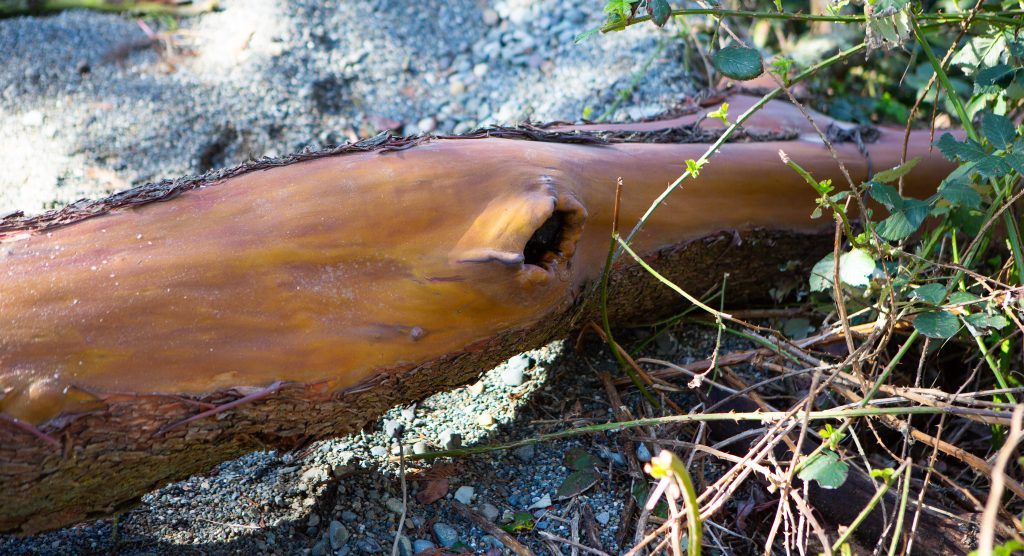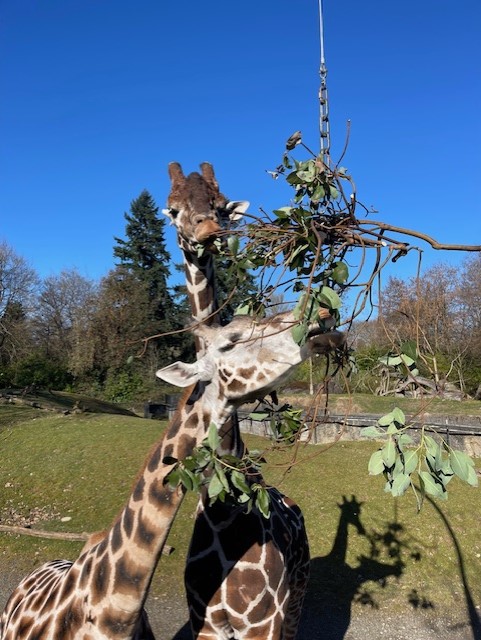
Date: March 20, 2024
There are countless ways the men and women of the Seattle Police Department work to improve quality of life for Seattle community members, but did you know that they also work to improve quality of life for the diverse fauna of the Woodland Park Zoo?
Just ask Dave the giraffe, as he happily munches on some of the delicious, leafy Pacific madrone branches that Woodland Park Zoo Browse Gardener Jillian Weed recently collected from the Mounted Patrol Unit grounds.
This fun partnership sprang to life in January, after high winds took down a sizeable Pacific madrone just outside the Mounted Patrol Unit barn. Pacific madrones, sometimes called strawberry trees or madronas, are a type of evergreen tree known for their striking beauty, intriguing growth patterns, green waxy leaves, and unique flaky bark. They are native to the Pacific Northwest, and just happen to live in abundance in the woodsy areas of the Mounted Patrol Unit’s park-like grounds in West Seattle.

Pacific madrones are attractive, sturdy, and nontoxic, and their smooth, leafy branches make excellent “browse,” which are plant materials used by the Woodland Park Zoo to enrich the lives of the animals who live there.
The Mounted Patrol Unit shares a property line with the Seattle Department of Transportation (SDOT), which has an existing partnership with the Zoo to provide browse. When SDOT noticed the fallen madrone in January, they pinged the MPU barn manager, who invited the Zoo to come out to West Seattle to salvage the tree.
Recent wind gusts took down another of the MPU’s Pacific madrones, so Zoo staff returned last week to collect another one of the prized evergreens.
As it turns out, the Pacific madrone has an extensive list of unique features and qualities that make it optimal for Zoo use. It’s exceptionally hard, strong, and nutrient-dense, and its branches offer a naturally compelling twisty shape, making it both durable and fun to look at. The bark and the wood are beautiful, and weather well. Even as animals interact with it, pulling at its bark, and chewing on the wood, it retains its distinctive elegance, which enhances the appearance of the exhibits.
While the smaller leafy branches make excellent fresh browse, the thicker, more substantial sections of the tree are used as perching wood.
“Some of this is probably going straight into the gorilla enclosure, which we’re re-perching right now,” said Exhibits Technician Ron Darling. “There really aren’t any places that we can’t use it.”

Another advantage of the Pacific madrone is that the wood has natural cavities, which give zookeepers clever places to stash other enrichment items for animals to forage and find. Additionally, the natural crevices give exhibit technicians places to hide any hardware needed to position the branches inside the exhibits.
When using the leafy madrone branches as browse in the giraffe enclosure, Weed hangs it high to mimic the acacia trees giraffes commonly eat in the wild. In addition to environmental enrichment, browse offers a variety of benefits for the animals, helping to keep them busy, stimulate their minds, and activate their natural foraging instincts.

Dave the giraffe, who has lived at the Woodland Park Zoo since 2014, is especially fond of the Pacific madrone browse, which apparently says a lot about the tree’s yumminess.
“Dave is very, very particular,” Darling said.
In addition to giraffes and gorillas, Pacific madrone donated by the Mounted Patrol Unit will be used as enrichment for sloth bears, snakes, rhinos, birds, and more.
The opportunity to maximize a resource like the Pacific madrone is in alignment with the Zoo’s devotion to conservation and its commitment to providing high quality, ethical care to the 800-plus animals and 250 different species that live on its vibrant 92 acres.
Madrones are special. A person wouldn’t just cut down a Pacific madrone tree, explained Weed, so being given access to madrones that have fallen naturally is a gift.
“It’s so important to think about resources and sustainability,” Weed said. “This is a real treat, especially during this time of year.”
We love this partnership between the Seattle Police Department and the Woodland Park Zoo and are excited to visit the Zoo to see the madrone branches in the exhibits! We’re very grateful to our new friends at the Zoo for taking the time to educate us about browse and everything else that goes into caring for the animals at Woodland Park Zoo.
Giraffe photos by Giraffe Keeper Lauren Sutherland-Cook/Woodland Park Zoo
All other photos by Seattle Police Foundation staff





